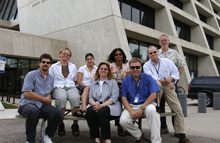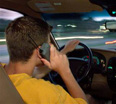 | Monday, October 3, 2005 |
|
Monday, October 3 2:30 p.m. Particle Astrophysics Seminar - Curia II Speaker: R. Wigmans, Texas Tech University Title: Neutrinos in an Expanding Universe 3:30 p.m. Director's Coffee Break - 2nd Flr X-Over 4:00 p.m. All Experimenters' Meeting - Curia II Special Topic: Homeland Security Presidential Directive 12
Tuesday, October 4 |
|
|
Secon Level 3 |
|
Monday, September 19 - Potato Au Gratin - Monte Cristo - Savory Roasted Chicken Quarters - Lasagna Bolognaise - Chicken Ranch Wrapper - Assorted Pizza Slices - Szechuan Style Pork Lo Mein The Wilson Hall Cafe accepts Visa, Master Card, Discover and American Express at Cash Register #1. |
|
Wednesday, October 5
Thursday, October 6
Chez Leon Menu |
| Fermilab Today is online at: http://www.fnal.gov/today/ Send comments and suggestions to today@fnal.gov Fermilab Today archive Hurricane Relief Page Fermilab Today PDF Version Fermilab Result of the Week archive Fermilab Safety Tip of the Week archive Linear Collider News archive Fermilab Today classifieds Subscribe/Unsubscribe to |
|
From Physics Web, September 27, 2005 New look for laser accelerators Physicists in the US have developed a new type of laser-based particle accelerator. Tomas Plettner and co-workers at Stanford University and the Stanford Linear Accelerator (SLAC) used a commercial laser operating at a wavelength of 800 nm to modulate the energy of electrons travelling in a vacuum. The modulation they achieved was equivalent to an electric field gradient of 40 million volts per metre. The technique could be used to accelerate particles into the TeV energy range in the future (Phys. Rev. Lett. 95 134801).
Conventional accelerators have to be hundreds of metres in length, or longer, to accelerate particles to energies of interest to particle physicists. In recent years, scientists have developed a variety of techniques, mostly based on laser-produced plasmas, that are able to achieve much higher acceleration gradients than conventional accelerators. This opens the possibility of significantly reducing the length of these machines. However, some of these techniques suffer from synchrotron radiation losses or poor beam quality, which will limit their appeal to particle physicists.
|
|
Distracted Driving |
|
We all hope that everyone on the road is focused and attentive to the safe operation of their vehicles.
At any moment during daylight hours in 2004, eight percent of drivers were talking on cell phones. As expected, this is a growing trend; cell phone usage was four percent in 2000 and six percent in 2002 (NHTSA). It may seem obvious that talking on a phone can be distracting, but controversy remains about whether it actually contributes to accidents. A recent paper in the British Medical Journal provides convincing evidence that cell phone use does increase the likelihood of an accident. The study took place in Perth, Australia between April, 2002 and July, 2004. It involved 456 drivers who used cell phones and were involved in accidents that required hospital visits. Cell phone use at crash time was determined from interviews and phone company records. The study concluded that cell phone use within 10 minutes before a crash was associated with a fourfold increase in crash risk (p<0.001). The increase did not depend on driver age, gender or whether a hands-free device was being used. Presumably, it is the distraction caused by conversion that is the source of the risk and not the handling of a phone. |
|
September 28 - 30 - During this 48 hour period, 1 store provided 33 hours and 45 minutes of luminosity. - TeV helium leak - Pbar AP1 vacuum leak - NuMI Horn problems Read the Current Accelerator Update |
|
Volunteer for Girl Scout Projects On November 12, from 9 a.m. to 3 p.m., there will be a Fermilab Girl Scout Badge workshop on site. Volunteers are needed to help with cemetary and village history projects, the prairie harvest, Ask A Scientist/Engineer-type activities and various other things during this event. Anyone and everyone is welcome to help out! If you have any questions or wish to volunteer contact Anne at Lucietto@fnal.gov.
Upcoming Classes
Identity Theft Prevention Class |

